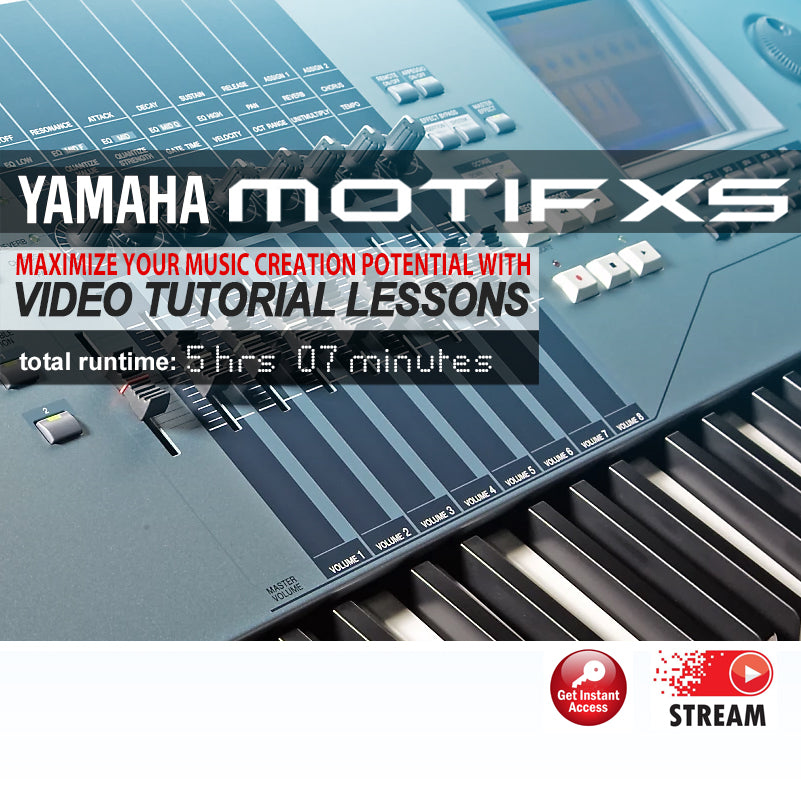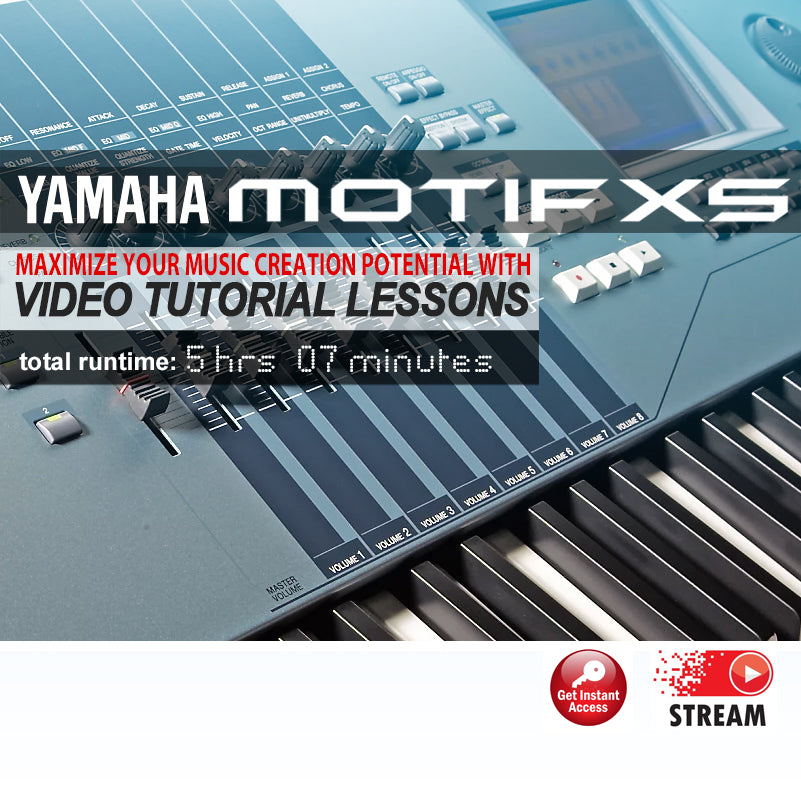sudosonic
Yamaha Motif XS Video Tutorial
Yamaha Motif XS Video Tutorial
Couldn't load pickup availability
Video Tutorial for the Yamaha Motif XS
Total Runtime: 5hrs 7mins
Watch a video lesson from our Yamaha Motif XS course.
Overview
This instructional video course is for the Motif XS. Our videos dig deep and explore practical and useful applications for the music creation process.
About the Author
Paul Duffey is veteran workstation instructor of 20+ years and is a partnering founder and moderator of TritonHaven.com. He is also certified trainer and video content provider for other affiliates such as TechnicalLead.com.
Video Lesson Lists
Sequencing
1. Introduction (Runtime 3:24mins)
In this video you'll get an overview of work flow on song mode for the Motif XS.
2. Play Modes (Runtime 3:07mins)
Explore the play modes and discover how they relate to one another.
3. Voice Selection (Runtime 3:11mins)
Paul explains how to navigate to different voice sounds using the bank selections.
4. Category Select (Runtime 4:33mins)
Learn how to select voices based on category criteria.
5. Arpeggio Controls (Runtime 4:33mins)
Learn how to change common realtime parameters and actually switch arpeggios.
6. Tone Controls (Runtime 5:17mins)
In this video Paul explains how to use the tone controls on the front panel. Use these to edits attack, and filtering parameters.
7. Multipart Control Screen (Runtime 2:43mins)
8. Store Voice Edits (Runtime 2:26mins)
9. Performance Record (Runtime 6:18mins)
In this video you'll learn how to record from a performance into sequence mode. This is common task where you might play a groove dialed into performance mode, and actually record what you play instantly with the track and arpeggio parameters copied into song or pattern mode.
10. Name Song (Runtime 1:18mins)
11. Track Loop (Runtime 3:20mins)
In this lesson you'll see how to easily set up tracks and track ranges to loop during playback in order to audition takes.
12. Song Record MIDI (Runtime 3:05mins)
13. Event Copy (Runtime 7:47mins)
Event copy is one of the most commonly used features in arranging with a linear sequencer. This video explains how to copy recorded portions of notes to other locations in your song in order to build up your song.
14. Mute/Solo (Runtime 1:48mins)
15. Erase Event (Runtime 3:06mins)
16. Record Arpeggio (Runtime 9:26mins)
17. Simple Mixing (Runtime 2:30mins)
18. Scenes (Runtime 4:17mins)
Scense are a new function in the Motif XS that allow you to save multiple mixer settings of the same song where as normally you'd have to save a copy of the song to another location.
19. Event Edit (Runtime 3:09mins)
In this video you'll learn how to make changes to individual notes in your tracks.
20. Mixing Common Edits (Runtime 8:27mins)
21. Mixing Part Edits (Runtime 16:37mins)
Paul explains the many edits that can be performed mix settings, including changing what voice assignment is assigned. You'll also be able to change voice type edits to the instant of the voice in sequencer mode independently from the voice in actual voice mode.
22. Save Songs (Runtime 5:57mins)
23. Factory Reset (Runtime 2:34mins)
In the event that you change something major you can always easily go back to the factory reset. Paul explains the steps to do this, and discusses why this may and may not be the best thing to do if you get in a bind.
24. Pattern Overview (Runtime 4:59mins)
This video is a very comprehensive video that shows how pattern mode works in the Motif XS. A lot of people easily get confused with what a "pattern" is because so many workstations and software use this term.
25. Record Pattern (Runtime 3:04mins)
26. Pattern Edits (Runtime 1:38mins)
27. Phrase Explained (Runtime 4:24mins)
In this lesson you'll learn what phrases are and how they are used in pattern mode of the Motif XS.
28. Record Arpeggio Pattern 1 (Runtime 4:36mins)
29. Record Arpeggio Pattern 2 (Runtime 2:40mins)
30. Copy Phrase (Runtime 4:04mins)
31. Loop Remix (Runtime 2:40mins)
Discover how loop remix can mix your beats and phrases beyond recognition.
Voice/Performance Editing
32. Voice Common General (Runtime 8:45mins)
Paul explains some of the edits that can be performed under the general tab in voice Edit mode.
33. Voice Common Other (Runtime 10:55mins)
In this lesson you'll learn some of the other common edits for voice mode. The common edits pertain to edits made to the entire voice.
34. Voice Element Oscillator (Runtime 8:19mins)
Learn how to adjust oscillator parameters of an element used in a voice. This is where you change what core sound is used, as well as some basic playback settings.
35. Voice Element Pitch Edits (Runtime 12:44mins)
In this video you'll learn how to adjust pitch parameters for elements used in a voice.
36. Voice Element Filter Edits (Runtime 17:57mins)
Filtering controls the "tonal brightness" of a sound. Learn how to edit initial filters and how filtering takes place over time with filter EGs (Envelope Generators).
37. Voice Element Amp Edits (Runtime 6:32mins)
Under the element amps tab you'll learn how to adjust controls that change the volume of an element. This can be used over time with EGs in order to create changes in attack and decay to create for example "soft strings" and "hard strings".
38. Voice Element LFO Edits (Runtime 2:02mins)
This video explains how to edit the LFO (Low Frequency Oscillator) for an element. This can be used to create a siren or tremelo effect by assigning it's output to control pitch or amp parameters in real time.
39. Voice Drum Edits (Runtime 9:32mins)
In this video Paul explains how to select and edit drum voices. This is a little different than other voices because of how keys play different drum sounds, those assignments are selected per key, not per element.
40. Performance Controls (Runtime 3:32mins)
In this video you'll learn how to take control of the performance controls using realtime control sliders, tabs, and knobs.
41. Performance General Edits (Runtime 3:48mins)
42. Performance Common Edits (Runtime 6:11mins)
This vidoe explains how to edit parameters that are common to a performance.
43. Performance Part Edits (Runtime 10:07mins)
in this video you'll learn how to adjust parameters to individual parts in a performance.
44. Performance Splits (Runtime 3:56)
In addition to the Performance part edits, this video is included to quickly show you how to set up parts to be splits in a performance.
Sampling
1. Sampling Overview (Runtime 3:13mins)
This video is a overview of sampling in the Motif XS. After watching this video you'll have a better understanding of what sampling is and how to set up the workstation to sample with the use of installed aftermarket RAM.
2. Sampling Setups (Runtime 3:10mins)
This video explains some of the internal settings required to connect devices to be sampled into the Motif XS. You'll learn gain adjustment, mode selection, as well as advice for connecting for the first time.
3. Sampling Record Pattern Mode (Runtime 5:38 mins)
In this lesson Paul walks you through the steps to record a sample to be used in a section of a pattern in pattern mode.
4. Sampling Initial Wav Edits (Runtime 5:35mins)
After you've recorded a sample there are some initial edits that can be made to a sample. In this video you'll be able to edit start and loop points to optimize playback.
5. Sampling Slice (Runtime 6:26 mins)
In this video you'll learn how to slice a sample loop into different parts to be triggered with the sequencer. This is one of the more common ways for samplers to compensate different playback tempos in a song.
6. Sampling Jobs (Runtime 5:12 mins)
Paul explains some of the sample job functions. This is where you will perform cut, copy, paste, as well as normalize commands to strengthen signal quality.
7. Sample Save (Runtime 2:45 mins)
After you've performed edits to your sample you'll want to back them up to a storage device. Samples are stored in RAM and lost after you powerdown.
8. Sample Record Song Mode (Runtime 4:51 mins)
This lesson shows you how to record a sample into a sequence in song mode. This is the mode you'll use for instrument solos as well as vocal recordings.
9. Sampling Voice Mode (Runtime 7:15 mins)
In this video you'll learn how to sample single instrument sounds and apply those to be used as elements in voice mode.
Working with PC
1. USB Connection Parameters
In this video you'll learn the internal settings for connecting the Motif XS via USB to your PC.
2. Motif XS Editor/Install
In this video you'll learn how install and configure drivers and software to use the Motif XS Editor.
3. Using the Editor
Paul shows how to use the Motif XS editor as a standalone editor to edit sounds in song and pattern mode. You'll also learn how to use the Motif XS Editor and Motif XS in combination with DAW software such as Cubase and Sonar as a sound module.
Share


